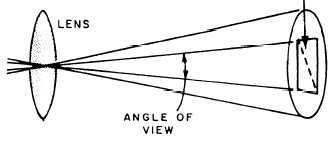Figure 1-21.–Angle of field.
closely resembles the central vision coverage of the
human eye. Wide-angle lenses have a large or wide
angle of field Long focal-length lenses (often called
telephotolenses) have a narrow angle of field (fig. 1-21).
Angle of View.–Angle of view determines the
coverage of a lens with a particular size of film, with the
lens-to-film distance remaining unchanged. Angle of
view is an angle with the intercept point at the lens and
its sides matching the corners of the film.
The angle of view (fig. 1-22) of a normal focal-
length lens with a given film size can approach but never
exceed the angle of field of the lens. Any lens recording
an angle greater than 55 degrees with a given film size
has a short-focal length and is called a wide-angle lens.
Any lens with an angle of view less than 45 degrees with
a given film size has a longer focal length.
Lens Diaphragm
The diaphragm of a lens is an opening in the lens
that allows light to pass through it to expose the film (or
other recording medium). This opening can be made
larger or smaller to allow more or less light to pass
through the lens. When the diaphragm opening is very
Figure 1-22.–Angle of view.
large, only the object that the lens is focused on is in
sharp focus. As the diaphragm opening is reduced (made
smaller), more objects in a scene, both in front and
behind the point of focus become sharper. The lens
diaphragm is used in conjunction with the shutter of
the camera to control the amount of light to expose
the film.
PERSPECTIVE
The human eyes see objects in three dimensions, but
a lens reproduces a view in two dimensions. The missing
dimension, depth, is suggested by the relative size and
position of the various objects in a picture. Perspective,
which is the relationship of objects in a photograph,
affects the naturalness of a picture. Good perspective
represents objects as they actually appear to human
eyes.
Since wide-angle lenses take in a greater area, most
photographers use them to photograph in tight quarters.
And they use long-focus (long focal length) lenses to
bring distant objects closer. This is fine, but it is only
part of the story. Lenses of different focal length are also
used to control perspective.
Perspective is NOT dependent on the focal length
of the lens. It is a function of camera-to-subject distance.
But a choice of lenses of a different focal length does
enable you to get the desired image size at the selected
distance for best perspective. For example, suppose you
come across a placid farm scene. A rustic rail fence is in
the foreground, and a cow is munching on a haystack in
the field. The cow and her lunch are 100 feet behind the
fence; you are 10 feet in front of the fence. The fence is
essential to your picture and you use a 50mm lens. The
result! The cow is 110 feet from the camera and is too
small in relation to the fence. Your picture is a flop. Now
change your perspective. Back up 40 feet from the fence
1-17

